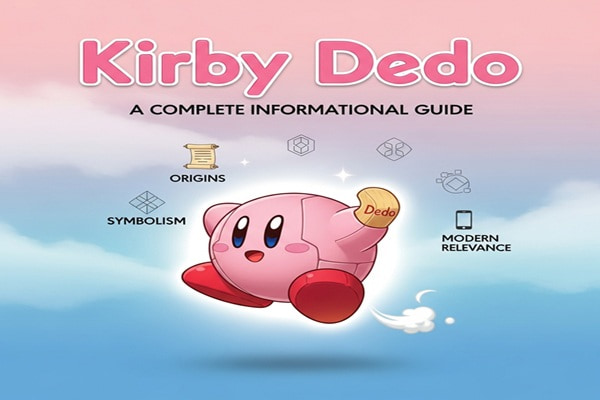
If you’ve ever stumbled into a late-night gaming thread or found yourself lost in fan theories about Kirby, you’ve probably seen the phrase “Kirby Dedo” floating around. At first glance, it sounds cryptic—almost like an inside joke between long-time fans. But behind that playful name lies a fascinating blend of creativity, symbolism, and community-driven storytelling that’s been quietly reshaping how fans connect with Nintendo’s round pink hero.
Let’s take a journey into what Kirby Dedo really means, how it began, and why it continues to inspire artists, coders, and gamers worldwide.
The Mysterious Origins of Kirby Dedo
Like most great internet phenomena, Kirby Dedo didn’t start with an official release or announcement. Instead, it evolved from the creative corners of online fan communities. The phrase itself likely began as a mash-up between Kirby—the beloved Nintendo character—and Dedo, a playful reinterpretation that hints at Dedede, Kirby’s rival and sometimes ally, King Dedede.
But over time, “Kirby Dedo” became something much bigger than a nickname. Fans started using it to describe experimental fan projects, from indie-style games and animated loops to AI-generated remixes of Kirby’s world. It wasn’t just a meme anymore—it was a movement that blended coding, art, and fandom into something uniquely interactive.
A Symbol of Creativity and Collaboration
What makes Kirby Dedo so fascinating is how it became a symbol for the modern fan-creator. Instead of passively consuming games or waiting for official sequels, fans began using the “Dedo” tag to share their own imaginative reworks of Kirby’s universe. You’d find everything from pixel-art reinterpretations and rhythm-based mini-games to open-source fan tools coded in Python or Unity.
The philosophy was simple: keep Kirby’s spirit of joy, color, and playfulness—but reimagine it through your own creative lens.
That’s the heart of what Kirby Dedo stands for: a creative remix culture powered by love and nostalgia.
The Digital Evolution: From Art Boards to Game Engines
The rise of Kirby Dedo can be traced across platforms like Reddit, Discord, and GitHub. Artists posted concept sketches, musicians shared lo-fi “Dream Land” remixes, and developers started building experimental engines inspired by Kirby’s gameplay physics. Some fan developers even coded AI-driven versions of Kirby that respond dynamically to music or player rhythm—melding art, sound, and interactivity in fresh ways.
This new digital creativity wasn’t about copying Nintendo’s IP; it was about exploring what Kirby represents—innocence, adaptability, and optimism.
Kirby Dedo, in that sense, became a community-made metaphor: proof that fans can both respect and reinvent their favorite icons.
The Philosophy of Kirby Dedo
If you look closer, there’s something deeper beneath the pink aesthetic and endless remixing. Many creators describe Kirby Dedo as a philosophy of joyful experimentation—a reminder that creation doesn’t always need corporate approval or perfection.
Here’s how fans interpret it:
-
Absorb and evolve: Just like Kirby inhales abilities, creators “absorb” tools, ideas, or influences to create something new.
-
Keep it lighthearted: The best Kirby Dedo projects don’t take themselves too seriously. They’re fun, expressive, and community-driven.
-
Code with emotion: Many fan coders involved in Kirby Dedo emphasize emotional connection over technical perfection—music-driven animations, reactive lighting, or soft color gradients that “feel” alive.
This fusion of play and purpose turned Kirby Dedo into more than a trend—it became a small artistic philosophy shared among fans worldwide.
Why Coders Fell in Love with Kirby Dedo
Here’s something unexpected: many indie developers and coders embraced Kirby Dedo not just as a visual aesthetic but as a design challenge.
They began experimenting with how to bring Kirby’s soft, physics-driven mechanics into open-source projects. Think of simple 2D engines with fluid motion, procedural animation, and light-reactive music cues. The idea wasn’t to recreate Nintendo’s Kirby, but to learn from its design DNA.
Some coders even referred to their experimental builds as “Dedo Frameworks”—test environments where motion, color, and music interact harmoniously. These projects often used minimal assets but focused deeply on feeling and flow.
That blend of music, code, and character emotion is what made Kirby Dedo a playground for both developers and artists alike.
The Music Connection
Music has always been at the heart of Kirby’s universe, and Kirby Dedo carries that legacy forward in remarkable ways.
Independent composers began to reimagine Kirby tracks using chiptunes, jazz, and ambient synths—sometimes even pairing them with procedurally generated visuals coded in Processing or Python.
For instance, one fan project visualizes sound frequencies as ripples across Dream Land’s skies, reacting in real time to the music. Others have used AI tools to blend Kirby melodies with lo-fi beats, creating soundscapes that feel nostalgic yet futuristic.
This mix of musical coding and emotional storytelling gives Kirby Dedo its unique rhythm—a digital heartbeat that syncs with creativity itself.
Ethical Creation and Respect for the Source
One reason Kirby Dedo stands out positively in the fan community is its ethical foundation. While it celebrates open creativity, the movement also promotes respect for copyright and fair use. Most Dedo-inspired projects operate under non-commercial terms, focusing on experimentation rather than profit.
Fans credit Nintendo’s creations, maintain transparency about project origins, and clearly mark derivative work. This responsible approach has allowed Kirby Dedo to thrive without major controversy—a rarity in fan-driven spaces.
The underlying message?
You can remix culture responsibly. You can experiment, play, and share while still honoring the creators who inspired you.
The Emotional Core: Why Fans Connect Deeply
What keeps Kirby Dedo alive isn’t just art or tech—it’s emotion. There’s something profoundly human about taking a simple, cheerful character and using it to express complex feelings like nostalgia, creativity, and belonging.
Fans describe it as a digital comfort zone—a place where you can code, draw, or compose without judgment. Many creators even use Kirby Dedo as a form of stress relief or digital journaling, channeling positive energy through art and collaboration.
It’s not about perfection; it’s about connection.
Kirby Dedo in the Broader Fan Landscape
To understand its impact, compare Kirby Dedo with other fan remix movements like Undertale AU projects, Sonic EXE mods, or Minecraft music videos. While many of those communities focus on darker or competitive interpretations, Kirby Dedo keeps things bright, inclusive, and heartwarming.
It bridges multiple disciplines—coding, art, music, storytelling, and philosophy—under one pink, bubbly umbrella. That’s what makes it stand out.
As one fan on Reddit put it:
“Kirby Dedo isn’t just a project; it’s a feeling—a shared wavelength between creators.”
How to Join the Kirby Dedo Movement
If all of this has sparked your curiosity, getting involved is easier than you might think. You don’t need professional skills or expensive software—just creativity and an open mind.
Here are some ways to dive in:
-
Join online communities like Discord or GitHub groups dedicated to Kirby Dedo-inspired projects.
-
Experiment with code using beginner-friendly tools like Godot or Unity, focusing on movement, color, and sound synchronization.
-
Create visual or audio art—even a short animation or remix can contribute to the larger Dedo culture.
-
Collaborate: Many creators openly share assets and encourage partnerships on joint projects.
The goal isn’t fame—it’s expression. It’s about building something small, joyful, and uniquely yours.
Also Read : The Ultimate Informational Guide to Albfilm24
The Future of Kirby Dedo
As 2025 unfolds, the Kirby Dedo movement shows no signs of slowing down. With AI tools becoming more accessible and cross-platform collaboration easier than ever, the potential for creative expansion is huge. We might see interactive soundscapes, AR-based Kirby experiences, or even community-built rhythm games inspired by the Dedo philosophy.
What began as a quirky online idea is now a digital art language that speaks to a generation raised on nostalgia and innovation. Kirby Dedo’s story reminds us that fan culture isn’t just about imitation—it’s about transformation.
Final Thoughts
Kirby Dedo is more than a mash-up of a name—it’s a celebration of what happens when imagination, technology, and emotion collide. It’s proof that even in an age of algorithms, real creativity still comes from people—dreamers, coders, and artists who see joy in simple shapes and endless possibilities.
So whether you’re a developer looking for inspiration or a casual fan who just loves Kirby’s charm, Kirby Dedo invites you to join in.
Pick up your tools, remix your world, and let your creativity float like a pink puffball across the digital skies.


